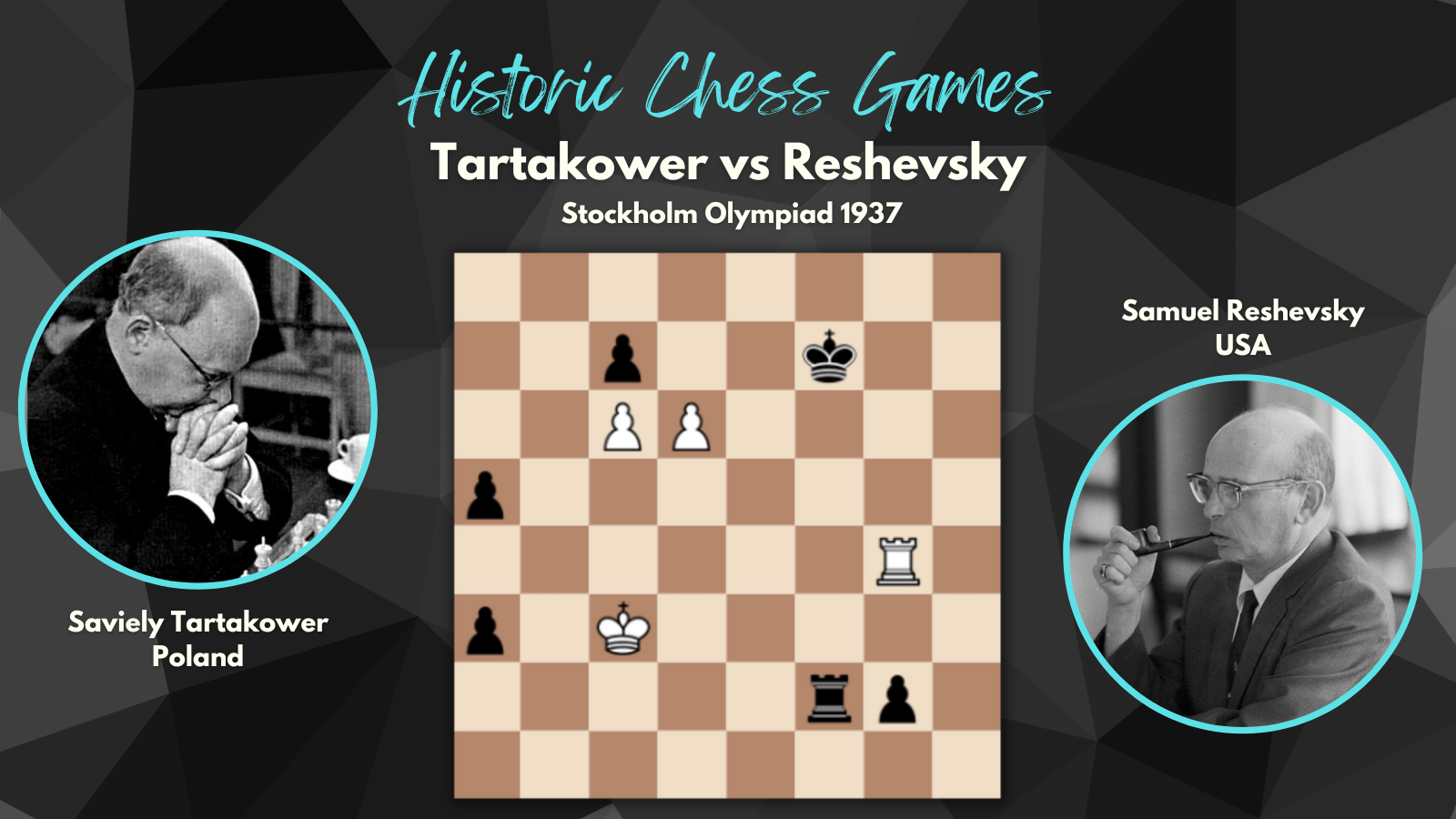Today we are looking at a 1937 Stockholm Olympiad game between Saviely Tartakower and Samuel Reshevsky. These two players were on top board for their respective countries. Ironically, the one who spoke no Polish (Tartakower) represented Poland, while the one who was born in Poland (Reshevsky) represented the USA. Reshevsky did not play in the previous official Olympiad (Warsaw Poland 1935) in case he was required to do military service for the land of his birth, despite his having become a US citizen.
1.e4 e5 2.d4 exd4 3.Qxd4
The primitive Center Game. A few top players have experimented with it, but not for long. The queen capture starts a clearance of the queenside so that White can castle there. The downside is that Black develops a knight with tempo. The next few moves have been seen on many occasions.
3…Nc6 4. Qe3 Nf6 5. Nc3 Bb4 6. Bd2 O-O 7. O-O-O Re8 8. Bc4 (This is the second favorite behind 8. Qg3) 8… d6 9. Nf3 Be6 10. Bxe6 Exchanging bishops is not compulsory.
10. Bd3 Bc5 11. Qe2 with near-equality.
10… Rxe6 11. Ng5 Re8 12. f4
12. f3 Ne5! (rather than 12… d5 13. Qf2 d4 14. Ne2 Bc5 (14… d3 15. Be3!) 15. Qf1.)
12… h6 13. h4
13…Qc8! The queen quits the d-file (in case that file gets opened), guards the h3-square from the white queen (in case the h-file gets opened), and — crucially — the black queen can come to g4.
The knight is untouchable: 13… hxg5?? 14. hxg5 Nxe4 15. Qh3 Kf8 16. Nd5+-.
14.Qf3 Kf8?! The unconvincing idea is to clear g8 for a retreat, and thus threaten to actually take the g5-knight, i.e. 15…hxg5 16.hxg5 Ng8.
But there is no need for that when the simple 14… Nd4! gives the white queen a headache over where to go.
15.Nd5?
Black’s wasteful king move gives White the time to consolidate with 15.a3 or 15.Kb1 before re-focusing on the kingside.
15… Nxd5 16. exd5 Nd4 17. Qd3 Ne2+ Now we see why the “consolidation” of the last note would have been useful. White is clearly worse. 18. Kb1 Bxd2
19.Rxd2
Alternatively 19. Qxd2 (from where the queen cannot reach the kingside) 19…Ng3 20. Rh3 Qg4!-+.
A possibly better try for White is 19. Ne6+!? fxe6 20. Rxd2 Nxf4 21. Rf2 (or 21. Rf1) 21… e5 22. g3 Qg4 and though Black will have to give the knight back he will be a safe pawn or two up. However, he could go wrong in the heavy piece ending.
19…Nxf4 20.Nxh7+ Best (but still not good enough). There now comes a semi-forcing sequence:
20…Kg8 21. Nf6+ gxf6 22. Qg3+ Ng6 23. h5 Qf5 24. hxg6 fxg6 Black is two pawns up and should win. 25. Rf2 Qg5 26. Qc3 Qe5
27.Rxf6 Qxc3 28. bxc3 Black returns a pawn in order to eliminate queens and ruin the white pawn structure. The game is as he wants it.
28…Kg7 29. Rf2 Rf8 30. Re2 Rae8 31. Rhe1 Rxe2 32. Rxe2 Rf1+ 33. Kb2 Kf7 34. c4 h5
35. Kc3 g5 36. c5 dxc5 37. Kc4 g4 38. Kxc5 g3 39. Kd4 h4 40. c4
40…b6 41. a4 Rf2 42. Re4 Rxg2 43. Rxh4 Ra2 44. Rg4 g2 45. a5 bxa5 46. Kc3 a4 47. c5
47…Kf6 Now the game gets interesting again.
47… Re2! has the idea of pushing the leading a-pawn. And note that 48. Kb4 fails to Re4+! 49. Rxe4 g1=Q-+.
47… Rf2 is inferior because if Black (stupidly) delivers a check on the 4th rank, White captures the rook with check.
48.Rg8 Ke5 49. Rg5+ Kf6
49… Kf4!, e.g. 50. d6 (or 50. Rg8 a3 51. Kb3 Re2 52. Kxa3 Re3+ 53. Kb4 Rg3-+) 50… Kxg5 51. d7 Ra3+! winning because the rook is now safe from a fork once both sides queen. On the third rank, the rook might also help to block a queen check later on. There’s a crucial rook check on a3 in a later comment too.
50.Rg8 White, who is losing, is happy to repeat the position (50.Rg8 equals 48.Rg8). 50…Kf7?? Black, in time trouble, is anxious not to continue the repetition (with 50…Ke5).
In which case he must play either 50… a5 or 50… Ke5. Even 50… a6?? is wrong (draws) because in some lines it allows the white king to go to b5.
51.Rg4 White misses his last, and unexpected, chance to draw.
51.d6!! and now 51…Kxg8 52. dxc7!
Avoiding 52. d7 Ra3+!! 53. Kc4 (53. Kb4 Rd3-+) 53… g1=Q 54. d8=Q+ Now, with the rook on the third rank, the black king can escape perpetual check by wandering down the board. Because, when the black king gets to g2 the rook can join in by blocking a queen check. That’s why 52…Ra3+ is so important and the only winning move.
52… g1=Q 53. c8=Q+ Kh7 54. Qh3+ Kg7
54… Kg6 55. Qe6+ picks up the rook.
54… Kg8 55. Qc8+ repeats.
55. Qd7+ and in the end, Black cannot avoid perpetual check or the equalizing loss of the rook.
51…a5
51…Re2 transposes to 47…Re2! in a note above. Black is back on a victorious path anyway.
52.c6 Ke7 53.Rg6
One source incorrectly gives “53.Rg3 Kf7 54.Rg4” (transposing) and so on. But of course 53.Rg3 would be answered by 53…Ra3+.
53… Kf7 54. Rg4 Rf2 55. d6 a3! This pawn will queen with check, unlike White’s pawn. It makes all the difference to the result. If White’s king was on b3 he would win easily as his queen, and not Black’s, would get to deliver the first check.
56.dxc7 a2 57. c8=Q a1=Q+ 58. Kc4 Rc2+ 59. Kb5 Qf1+ 60. Ka4 Ra2+ 61. Kb3 Qb1+ 62. Kc3 Rc2+ 63. Kd4 g1=Q+
63… g1=Q+ 64. Rxg1 Qxg1+ and Black will quickly deliver mate with a succession of checks.
0-1
Play through the full game here:
Marek Soszynski
Samuel Reshevsky had a colorful chess career – starting as a young prodigy who, at the age of 4 would play simultaneous games against adults, to becoming a Grandmaster and top player. Author Marek Soszynski explores his life and games in “The Great Reshevsky” with articles and newspapers from this time and a collection of annotated games.

Marek Soszynski is a master twice over: a Master of Philosophy and a Correspondence Chess Master.
He is the author or co-author of several chess books, including “The Great Reshevsky”, “The Polish Defense”, and “Sabotaging the Sicilian French & Caro-Kann with 2.b3” which you can find on Forward Chess.
He lives in the city where he was born, Birmingham, England.
- Rock Solid Chess: Volume 2 - February 21, 2024
- Unsung Heroes of Chess - February 19, 2024
- Build Up Your Chess: The Fundamentals - February 7, 2024

